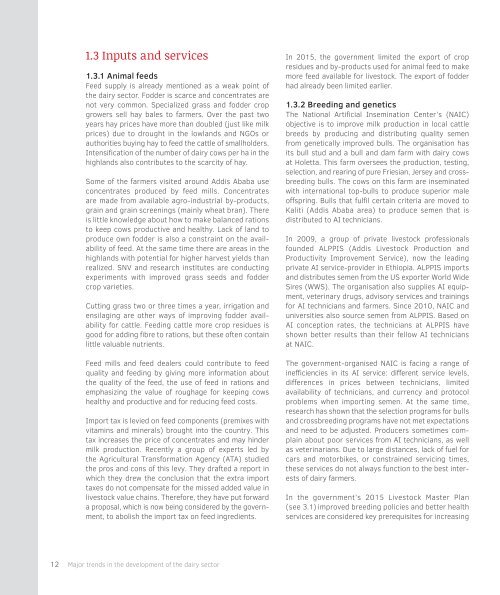Dairy sector
2DairyBOR
2DairyBOR
You also want an ePaper? Increase the reach of your titles
YUMPU automatically turns print PDFs into web optimized ePapers that Google loves.
1.3 Inputs and services<br />
1.3.1 Animal feeds<br />
Feed supply is already mentioned as a weak point of<br />
the dairy <strong>sector</strong>. Fodder is scarce and concentrates are<br />
not very common. Specialized grass and fodder crop<br />
growers sell hay bales to farmers. Over the past two<br />
years hay prices have more than doubled (just like milk<br />
prices) due to drought in the lowlands and NGOs or<br />
authorities buying hay to feed the cattle of smallholders.<br />
Intensification of the number of dairy cows per ha in the<br />
highlands also contributes to the scarcity of hay.<br />
Some of the farmers visited around Addis Ababa use<br />
concentrates produced by feed mills. Concentrates<br />
are made from available agro-industrial by-products,<br />
grain and grain screenings (mainly wheat bran). There<br />
is little knowledge about how to make balanced rations<br />
to keep cows productive and healthy. Lack of land to<br />
produce own fodder is also a constraint on the availability<br />
of feed. At the same time there are areas in the<br />
highlands with potential for higher harvest yields than<br />
realized. SNV and research institutes are conducting<br />
experiments with improved grass seeds and fodder<br />
crop varieties.<br />
Cutting grass two or three times a year, irrigation and<br />
ensilaging are other ways of improving fodder availability<br />
for cattle. Feeding cattle more crop residues is<br />
good for adding fibre to rations, but these often contain<br />
little valuable nutrients.<br />
Feed mills and feed dealers could contribute to feed<br />
quality and feeding by giving more information about<br />
the quality of the feed, the use of feed in rations and<br />
emphasizing the value of roughage for keeping cows<br />
healthy and productive and for reducing feed costs.<br />
Import tax is levied on feed components (premixes with<br />
vitamins and minerals) brought into the country. This<br />
tax increases the price of concentrates and may hinder<br />
milk production. Recently a group of experts led by<br />
the Agricultural Transformation Agency (ATA) studied<br />
the pros and cons of this levy. They drafted a report in<br />
which they drew the conclusion that the extra import<br />
taxes do not compensate for the missed added value in<br />
livestock value chains. Therefore, they have put forward<br />
a proposal, which is now being considered by the government,<br />
to abolish the import tax on feed ingredients.<br />
In 2015, the government limited the export of crop<br />
residues and by-products used for animal feed to make<br />
more feed available for livestock. The export of fodder<br />
had already been limited earlier.<br />
1.3.2 Breeding and genetics<br />
The National Artificial Insemination Center’s (NAIC)<br />
objective is to improve milk production in local cattle<br />
breeds by producing and distributing quality semen<br />
from genetically improved bulls. The organisation has<br />
its bull stud and a bull and dam farm with dairy cows<br />
at Holetta. This farm oversees the production, testing,<br />
selection, and rearing of pure Friesian, Jersey and crossbreeding<br />
bulls. The cows on this farm are inseminated<br />
with international top-bulls to produce superior male<br />
offspring. Bulls that fulfil certain criteria are moved to<br />
Kaliti (Addis Ababa area) to produce semen that is<br />
distributed to AI technicians.<br />
In 2009, a group of private livestock professionals<br />
founded ALPPIS (Addis Livestock Production and<br />
Productivity Improvement Service), now the leading<br />
private AI service-provider in Ethiopia. ALPPIS imports<br />
and distributes semen from the US exporter World Wide<br />
Sires (WWS). The organisation also supplies AI equipment,<br />
veterinary drugs, advisory services and trainings<br />
for AI technicians and farmers. Since 2010, NAIC and<br />
universities also source semen from ALPPIS. Based on<br />
AI conception rates, the technicians at ALPPIS have<br />
shown better results than their fellow AI technicians<br />
at NAIC.<br />
The government-organised NAIC is facing a range of<br />
inefficiencies in its AI service: different service levels,<br />
differences in prices between technicians, limited<br />
availability of technicians, and currency and protocol<br />
problems when importing semen. At the same time,<br />
research has shown that the selection programs for bulls<br />
and crossbreeding programs have not met expectations<br />
and need to be adjusted. Producers sometimes complain<br />
about poor services from AI technicians, as well<br />
as veterinarians. Due to large distances, lack of fuel for<br />
cars and motorbikes, or constrained servicing times,<br />
these services do not always function to the best interests<br />
of dairy farmers.<br />
In the government’s 2015 Livestock Master Plan<br />
(see 3.1) improved breeding policies and better health<br />
services are considered key prerequisites for increasing<br />
12 Major trends in the development of the dairy <strong>sector</strong><br />
<strong>Dairy</strong>BOR_ver1.indd Cont12 2015.10.29. 23:32:21


